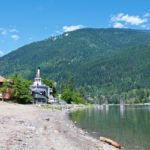Our neck of the woods near Nelson is a really beautiful part of British Columbia. The roads along the lakes, valleys and over the passes are amazingly scenic. In an electric vehicle, you can drive a little slower with the windows down and really enjoy the scents and sounds of the mountains, or you can tighten your grip on the wheel and enjoy the instant torque of an EV on our twisty roads (safely of course!)
On this sunny day in June 2016, we travelled along the shores of Kootenay Lake to nearby Kaslo. After a tour of the SS Moyie and a light lunch (while charging at the local campground), we headed away from the lake, up over the pass and down to New Denver on the shores of Slocan Lake. We stopped for a short walk in an old cedar/hemlock forest on the way. My wife and her mom visited the Nikkei Internment Centre while the boys and I played in the park and swam in the lake (the car was charging at the campground while we were doing this).
Watch the video below for some fantastic scenery! (And photos further down this page)
At 9:20 or so in the video, I mentioned a wanting to take trip back to New Denver to hike Idaho Peak in July; we never did get back with the Leaf that summer, though we did do the hike in mid-September while in New Denver for the Hills Garlic Festival on a quick day-trip with our Subaru Forester. Maybe we will get to it this year! Those of you with longer-range EVs, you could do it as a day-trip from Nelson now (e.g. a Bolt, or Model S/X [with air suspension on high!]).
(click any photo below to open the gallery)
- The trail is a bit exposed in some areas like this, but it is reasonably wide and well graded, and the total climb and distance isn’t that large. The kids walk the whole way themselves (with breaks of course!)
- A fall snow squall had come through just prior to our hike, in the shady areas the snow lingered for a few hours
- Lots of neat gnarly windswept trees on the ridgetop that you follow for most of the hike
- The sun setting over Slocan Lake behind the Valhalla mountains
- Looking south down Slocan Lake as the sun sets behind the mountains
- This swim dock is just off the beach from the New Denver campground
- Playing in the water of Slocan Lake – even in early June it was ok for swimming (weather had been pretty hot last week or so)
- Charging in the campground at New Denver
- Many tall cedars on the walk near Retallack
- They are soo cute when helping each other 🙂
- One of my favourite portraits of the boys
- The dining room of the SS Moyie
- Electrical panel in the SS Moyie
- This dynamo generated electricity for the vessel from the steam boiler
- The SS Moyie on the shores of Kootenay Lake beside downtown Kaslo
- Charging at the Kaslo campground while viewing the SS Moyie
Electric vehicle (EV) specifics for the trip:
We’ve done segments of this trip together, but never the loop in one day (click to enlarge):

Starting in Nelson, we drove east and north to Kaslo, then west over the mountain pass to New Denver, then back south and east along the Slocan Valley, and finally north back along the Kootenay River
With the new long-range EVs coming out (e.g. the Bolt, see my Available EVs page) you will be able to do this in one loop without having to stop to charge at all! You can re-create our trip with any vintage of modern EV; however right now you would need the special portable charger shown in our video (in order to use 24A off of the 120V/30A TT-30 RV outlets). BUT, I believe there will be Level 2 chargers installed in each of the towns in the next year or less, so anyone with an EV will be able to do this trip very soon (see Charging page for more info on our portable charger etc). Note that all charging was done during activity time, which means we DID NOT have to sit around and wait for the car to charge in this instance.
| Metric | Predicted | Actual |
| Distance (km) | 228 | 217 |
| Elevation Climbed & Lost (m) | 2135 | 2135 |
| Energy Used (kWh) | 33.7 | 28.2 |
| Energy Efficiency (km/kWh) | 6.8 | 7.7 |
| Consumption (Wh/km) | 150 | 130 |
| Battery % Used | 187% | 143% |
| Time Spent Charging (hr) | 6:15 | 6:00 |
| Total Trip Time (hr) | 11:00 | 11:00 |
So a note on this table; we had originally planned to only charge for 2 hours in New Denver (at 24A/120V), then move on to the campground at Slocan City which has a NEMA 14-50 (RV 50A) outlet, where we could charge at 28A/240V; however, we had used less energy to get to New Denver than we had estimated, so instead we stayed in New Denver for 2 hours longer (which was good because M and her mom needed more time in the museum!)
Our Nissan Leaf serves primarily as my commuter vehicle on weekdays, but it also does admirably as the regional trip vehicle too. When possible, we take the Leaf over our Subaru Forester. It is far more pleasant to drive an EV – the ride is so smooth and quiet, and the cost can’t compare. For this trip, we consumed 28.2 kWh at $0.091/kWh, or $2.57 CDN. In terms of energy equivalent, it was about equal to using 3.2 L of gasoline – of course no gas car could travel 217 km on that small amount of gas – a Prius could have approached 6 L on this journey (lots of long hills where regen on the battery is unavailable because of its puny size!), or $16.25 at today’s gas price of $1.25/L. And that isn’t even including the cheaper maintenance on our EV, no oil changes! Our Subaru consumes more fuel of course, so we saved even more. (And that is not even accounting for maintenance costs – grand total for the Leaf so far is ~$120 over 2 years and 80,000 km, at the time of writing. I’m now up to 110,000 km and haven’t spent anything more on maintenance. My annual check-up will add about another $120, which I will report on my Cost Info page in June.)
Now we await a suitable replacement for our Forester – AWD, a bit more cargo room than the Leaf, a bit more ground clearance, and a range of > 300 km should do it. I expect to see at least one option announced in 2017 (Model Y), with several actually arriving before 2020. Exciting times!
- R1T Efficiency Tests: Bikes and Ski Boxes - March 30, 2024
- Adding Outdoor Accessories to my R1T - December 1, 2023
- Why an EV truck? Why the R1T? - October 8, 2023

















Pingback: 2017 starts with a bang! – Kootenay EV Family
Love that neck of the woods, so much to see and do. Enjoyed the photos as well as the trip through your blog.